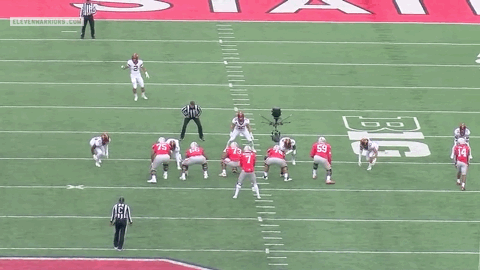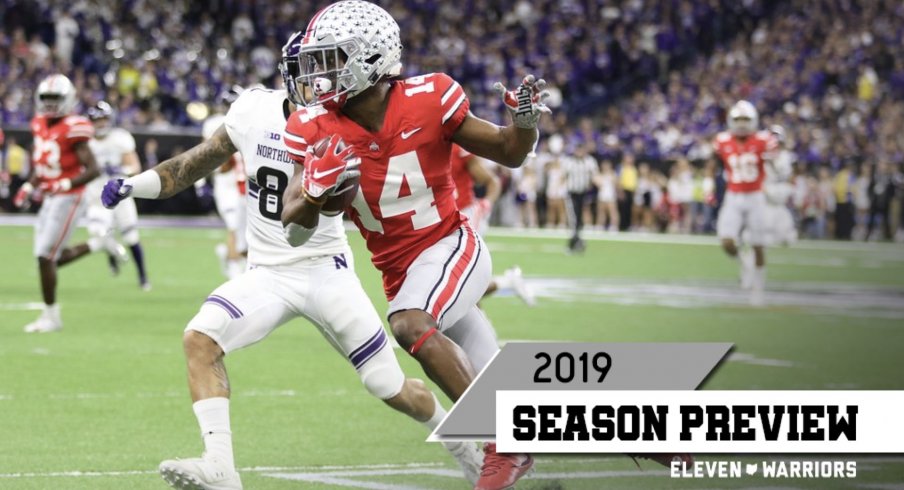"It's a lot of pressure, but I mean, you're at Ohio State. You're going to get everybody's best shot. You've got to be that offense, you've got to be explosive. That's what the fans expect, that's the standard at Ohio State." - K.J. Hill
Heading into his final training camp in Columbus, K.J. Hill understands the challenge before him. Despite featuring heavily in the most productive offense in school history last fall, Hill recognizes that expectations remain high among the Buckeye faithful, even as only a handful of familiar faces will line up next to him on Aug. 31 in Ohio Stadium.
Gone is the record-setting quarterback and three of his top targets, along with four of the five starting linemen who blocked for him. Of those that remain, former freshman phenom J.K. Dobbins has been considered the most likely beneficiary of the turnover, expected to be the lead back in a run-centric system.
Additionally, much of the focus throughout winter workouts, spring ball, and fall camp has been on the young man who will likely be getting Hill the ball this fall, sophomore transfer quarterback Justin Fields, and whether or not he'll be able to live up to the lofty standards set by his predecessors. But Hill believes that regardless of who lines up under center, the unprecedented production seen one year ago is not only possible but mandatory.
"I know the standard of the offense," Hill said at Big Ten Media Days last month. "Coach Day always talked about it, we did big things last year so there can't be a drop-off. It's got to be better than last year. I was apart of that group, I know what we did, I know everything we did under the table that people don't see."
What that group of wide receivers did was change the entire narrative surrounding not only their position group but of the passing game in general at Ohio State. Long known for a physical, ground-and-pound style, the Buckeyes are now known as one of the nation's most explosive aerial attacks, thanks in large part to their slight receiver in the slot.
Many doubters believe that perception won't last very long, with Dobbins and Fields expected to revive the zone-read now that three wideouts who combined for 167 catches, 2,433 yards receiving, and 31 touchdowns in 2018 wear NFL uniforms instead of the Scarlet and Gray. Since Hill might not have hauled in as many deep balls as Terry McLaurin or Johnnie Dixon, and may not possess the same straight-line speed as fellow H receiver Parris Campbell, his value to the OSU passing game could have easily been underestimated.
But despite playing fewer total snaps than all three, Hill was second on the team in receptions (68) and yards (865) last season. After rotating with Campbell in the slot, making it easily the most productive spot in Ryan Day's offense, Hill should receive the majority of playing time at the position this fall and has proven more than capable of handling all the rigors that come with it.
With 142 career catches under his belt, just 48 shy of David Boston's school record, Hill has shown his quickness in space on countless occasions, making him the perfect primary target in Day's cavalcade of crossing routes.
That same wiggle has makes him a dangerous threat on the edges as well, acting as the relief to keep defenses from overloading the box against Dobbins and the run. Though Fields showed he's comfortable acting as a runner in the option game, easy throws like a bubble screen are a great way for him to quickly build confidence while stretching the defense laterally.
But Day doesn't just use run/pass options (RPOs) as tags on the running game, as he'll also give his QB multiple reads on one play. When a safety plays soft coverage over Hill in the slot, that decision becomes an easy one, as the Buckeyes' punt returner averaged 7.7 yards after the catch last fall.
The 6'0" 194 lb Hill isn't afraid to fight for the ball in traffic, either. Many receivers who run curl, hitch, or comeback routes tend to wait for throws to reach them, especially when they feel defenders over the top. But as Hill showed against TCU's well-coached secondary, he not only found the soft spot in the zone but worked back to the ball and beat the defender, securing a first down.
But what separates Hill from most is the way he uses his quickness before the ball ever arrives. Even when matched up against nickel backs in man-coverage, the Arkansas native can still put them on skates and create enough space to give his quarterback an open window.

Add in the best hands anyone has seen since Michael Thomas was walking the halls of the WHAC, and you have a quarterback's best friend. On more than one occasion, Hill turned off-target throws from J.T. Barrett or Dwayne Haskins into big plays, which should give Fields the confidence to look for #14 whenever he needs a crucial completion.
Compared to previous iterations, the key differentiator in last year's OSU attack was the unit's ability to attack downfield. Haskins' exceptional arm strength and accuracy certainly played a part, but so did the speed and ball-tracking abilities of players like McLaurin and Dixon. Without their presence, many have speculated aloud about which young wideouts might fill the void they left behind, with Chris Olave and freshman Garrett Wilson emerging as the most likely candidates.
Hill, however, can contribute in this area as well. Though he is most dangerous using his lateral quickness to get open, he changes speeds and uses his hands to swat away contact when looking to win downfield.
Oh yeah, he can track the ball in the air pretty well, too.
This well-rounded skillset makes Hill invaluable to an OSU offense in need of leaders and playmakers. While most eyes will be on the backfield's starting duo, Hill's production may, in fact, be the key to unlocking the unit's success.
While it's unfair to ask him to shoulder the entire weight carried by a quartet of receivers last season, his example will be invaluable to the younger members of the corps. But eclipsing the 1,000-yard receiving mark is a very real possibility, knowing he'll essentially be filling the role of Campbell in addition to the one he held last fall.
That opportunity was what ultimately led him back to Columbus for a fifth and final season.
“I just wanted to make the best decision as possible, and I felt like staying was the best one,” Hill said in February. “I wanted to leave with no regrets. I wanted to put everything I could into my overall career, and here at Ohio State. So I stayed, so I wouldn’t have no regrets.”



